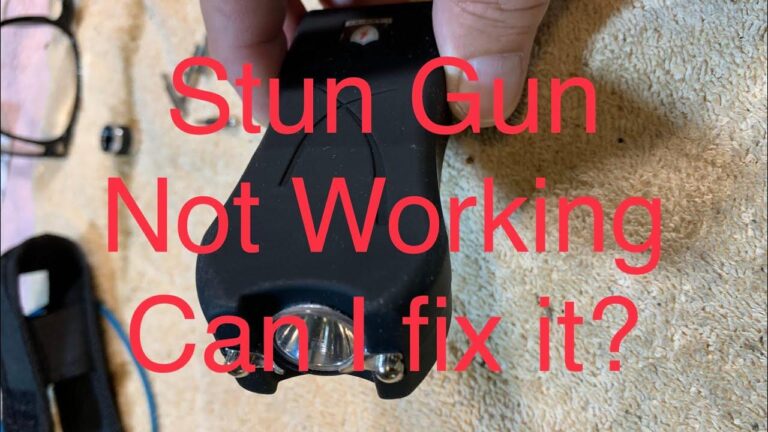Table of Contents
- Common Electrical and Battery Issues Preventing Activation
- Ensuring Proper Safety Switch and Trigger Functionality
- Cleaning and Maintenance Tips to Restore Connectivity
- When to Seek Professional Repair or Replace Your Stun Gun
- Insights and Conclusions
Common Electrical and Battery Issues Preventing Activation
One of the most frequent culprits for a stun gun failing to activate is electrical connection problems. Over time, internal wiring may become loose or corroded, interrupting the power flow needed for the device to function. It’s crucial to regularly inspect the device for any visible wear, especially around the activation button and terminal contacts. In many cases, dirt or moisture buildup can create a barrier, preventing the stun gun from firing effectively. Ensure terminals are clean and dry, as even slight oxidation can diminish conductivity.
The battery is another critical element often overlooked. A depleted or malfunctioning battery can cause the stun gun to remain unresponsive despite repeated attempts to activate it. Common signs of battery issues include dim indicator lights or weak spark output. To avoid this, keep these practices in mind:
- Regularly recharge the battery, especially if the device goes unused for extended periods.
- Replace batteries that show signs of swelling, leakages, or drastically reduced hold time.
- Use manufacturer-recommended batteries to ensure proper compatibility and voltage levels.
Ensuring Proper Safety Switch and Trigger Functionality
One of the most common reasons your stun gun fails to activate is due to issues with its safety switch or trigger mechanism. Many models are equipped with a built-in safety switch designed to prevent accidental discharge. If this safety is engaged, the electrical circuit won’t complete when you press the trigger, making activation impossible. Before attempting to use your device, always check that the safety switch is fully turned off or positioned correctly according to your stun gun’s instructions. Even slight misalignment can interrupt the internal connection necessary for the stun gun to fire.
In addition to the safety switch, the trigger itself can be subject to wear, debris, or mechanical malfunction. Over time, dust or dirt may accumulate inside the trigger housing, hindering its movement or preventing it from making proper contact. If your stun gun doesn’t activate even with the safety switch correctly disabled, try gently cleaning the trigger area with compressed air or a soft brush. If the problem persists, consider that the internal trigger contacts might be damaged or corroded-this often requires professional repair or replacement. Paying close attention to these components helps ensure your device performs reliably in critical moments.
- Always verify the safety switch is off before use.
- Inspect and clean the trigger area regularly.
- Seek professional service if internal trigger issues are suspected.
Cleaning and Maintenance Tips to Restore Connectivity
Ensuring your stun gun maintains optimal connectivity requires regular cleaning and careful upkeep. Start by disconnecting the device and using a soft, dry cloth to remove dust and debris from the electrodes and casing. If stubborn grime accumulates, a cotton swab lightly dipped in isopropyl alcohol can be used to gently clean the contact points. Avoid using water or harsh chemicals, as they can corrode the circuits or damage sensitive components. Additionally, inspect the device for any signs of corrosion or rust around the metal contacts, as these can disrupt the electrical flow needed for activation.
Beyond cleaning, maintaining battery health is crucial to restore and sustain connectivity. Regularly check the battery terminals for any buildup and ensure they’re firmly seated. If your stun gun uses rechargeable batteries, follow recommended charging cycles and avoid overcharging to preserve energy capacity. For those with replaceable batteries, use only manufacturer-approved types, and keep spares handy to avoid power interruptions. A simple but effective practice is to perform functionality checks once a month to detect issues early and prevent unexpected failures in critical moments.
When to Seek Professional Repair or Replace Your Stun Gun
If your stun gun continues to fail activation despite following basic troubleshooting steps, it might be time to consult a professional. Persistent issues like no response when pressing the trigger, visible internal damage, or unusual smells (often indicating electrical faults) can signal deeper problems that require expert diagnostics. Attempting repairs without proper knowledge or tools could worsen the damage or compromise safety, so entrusting your stun gun to a certified technician ensures a thorough inspection and precise repairs.
However, there are circumstances where replacing your stun gun is a smarter choice than repair. Consider replacing your device if it meets any of the following criteria:
- Highly outdated model prone to frequent malfunction.
- Extensive internal damage making repair costs unfeasible.
- Battery issues that cannot be resolved with replacements.
- Compromised safety mechanisms that affect reliable operation.
Insights and Conclusions
In conclusion, a stun gun that refuses to activate can be both frustrating and concerning, especially when you rely on it for personal safety. By methodically troubleshooting common issues-such as checking the battery, ensuring proper maintenance, and confirming correct operation-you can often restore your device to full working order. Remember, regular upkeep and understanding your stun gun’s functionality are key to preventing future malfunctions. If problems persist despite your best efforts, don’t hesitate to consult a professional or consider replacement options to ensure you always have reliable protection when you need it most. Stay safe and empowered!Check Our Other Blogs
- StunGun – Your Trusted Source for Stun Guns, Laws, and Self-Defense Tips
- PepperSprayLaws – Your Trusted Resource for Pepper Spray Information
- StunGunLaws – Your Trusted Guide to Stun Gun Legality and Safety





